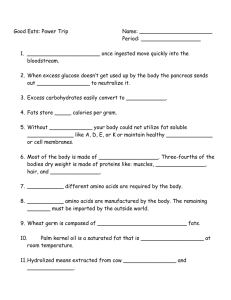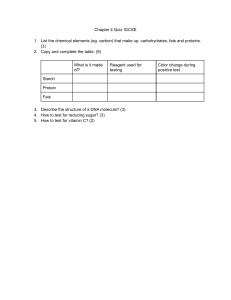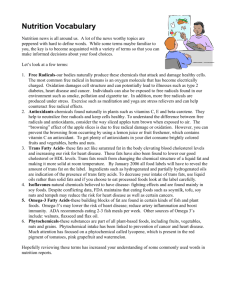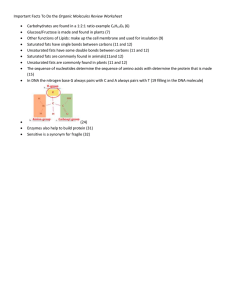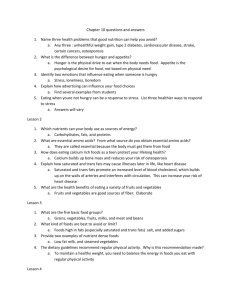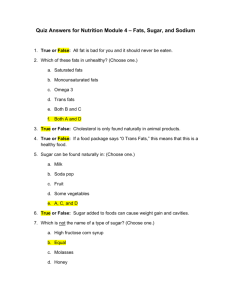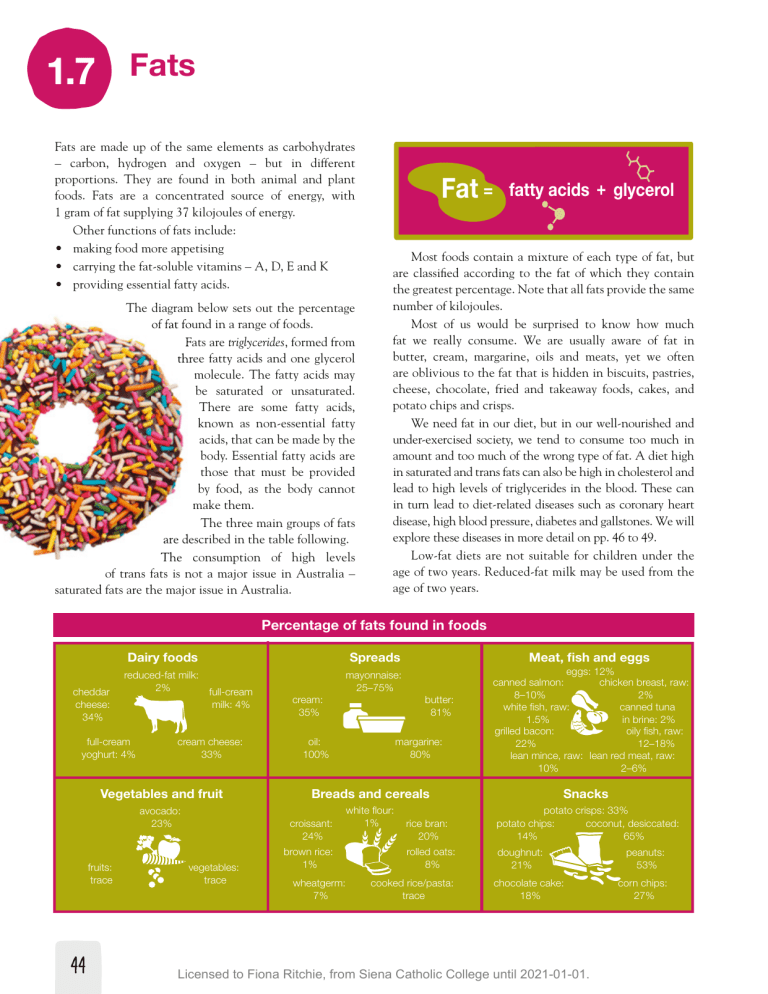
1.7 Fats Fats are made up of the same elements as carbohydrates – carbon, hydrogen and oxygen – but in different proportions. They are found in both animal and plant foods. Fats are a concentrated source of energy, with 1 gram of fat supplying 37 kilojoules of energy. Other functions of fats include: • making food more appetising • carrying the fat-soluble vitamins – A, D, E and K • providing essential fatty acids. The diagram below sets out the percentage of fat found in a range of foods. Fats are triglycerides, formed from three fatty acids and one glycerol molecule. The fatty acids may be saturated or unsaturated. There are some fatty acids, known as non-essential fatty acids, that can be made by the body. Essential fatty acids are those that must be provided by food, as the body cannot make them. The three main groups of fats are described in the table following. The consumption of high levels of trans fats is not a major issue in Australia – saturated fats are the major issue in Australia. Fat = fatty acids + glycerol Most foods contain a mixture of each type of fat, but are classified according to the fat of which they contain the greatest percentage. Note that all fats provide the same number of kilojoules. Most of us would be surprised to know how much fat we really consume. We are usually aware of fat in butter, cream, margarine, oils and meats, yet we often are oblivious to the fat that is hidden in biscuits, pastries, cheese, chocolate, fried and takeaway foods, cakes, and potato chips and crisps. We need fat in our diet, but in our well-nourished and under-exercised society, we tend to consume too much in amount and too much of the wrong type of fat. A diet high in saturated and trans fats can also be high in cholesterol and lead to high levels of triglycerides in the blood. These can in turn lead to diet-related diseases such as coronary heart disease, high blood pressure, diabetes and gallstones. We will explore these diseases in more detail on pp. 46 to 49. Low-fat diets are not suitable for children under the age of two years. Reduced-fat milk may be used from the age of two years. Percentage of fats found in foods cheddar cheese: 34% Dairy foods Spreads Meat, fish and eggs reduced-fat milk: 2% mayonnaise: 25–75% eggs: 12% canned salmon: chicken breast, raw: 8–10% 2% white fish, raw: canned tuna 1.5% in brine: 2% grilled bacon: oily fish, raw: 22% 12–18% lean mince, raw: lean red meat, raw: 10% 2–6% full-cream yoghurt: 4% cream cheese: 33% cream: 35% butter: 81% oil: 100% margarine: 80% Vegetables and fruit Breads and cereals Snacks avocado: 23% white flour: 1% rice bran: 20% potato crisps: 33% potato chips: coconut, desiccated: 14% 65% rolled oats: 8% doughnut: 21% fruits: trace 44 full-cream milk: 4% croissant: 24% vegetables: trace brown rice: 1% wheatgerm: 7% cooked rice/pasta: trace chocolate cake: 18% Licensed to Fiona Ritchie, from Siena Catholic College until 2021-01-01. peanuts: 53% corn chips: 27% Unsaturated fats – the good Do not contain the maximum amount of hydrogen • • • • Saturated fats – the bad Contain the maximum amount of hydrogen (i.e. they are saturated with hydrogen) • • • Trans fats – the ugly Created artificially by a process called ‘hydrogenisation’ whereby liquid oil is converted to solid fat in order to obtain the correct consistency • • • • Classified as either monounsaturated or polyunsaturated Often called ‘good’ fats because they can help decrease cholesterol The Australian Guide to Healthy Eating recommends that these fats be consumed in small amounts each day Found in sunflower, olive and canola oils and margarines, as well as in many nuts, seeds, fish and soy foods, such as tofu Found in both animal and plant foods, including fatty meat, dairy products, palm and coconut products, and commercially baked products Tend to increase low-density lipoproteins (LDL) in the blood, which can elevate cholesterol levels and therefore increase your chance of coronary heart disease According to the Australian Guide to Healthy Eating, foods high in saturated fats are ‘discretionary food choices’ and are to be consumed sometimes and in small amounts, because the link between consumption of saturated fats, blood cholesterol and cardiovascular disease is well established Considered most harmful to our health, but not found widely in Australian foods Like saturated fat, trans fats increase the level of bad LDL cholesterol; trans fats also lower the level of high-density lipoproteins (HDL) – or good cholesterol – in the blood, which protects against coronary heart disease May be found in foods such as pastries, cakes, biscuits, and in some deep-fried foods and processed food, as well as naturally in some foods such as meats Manufacturers in Australia are not required to include information about trans fats unless they make a claim about unsaturated fats or cholesterol; if no claim is made, the manufacturers are only required to include information on their label about total and saturated fats – therefore, some foods can contain trans fats and not display that fact on the label LET’S REVIEW Let’s examine 5 1 How much energy is contained in 1 gram of fat? 2 Identify the various functions of fats. 3 Identify the two main types of fats found in Australian foods and create a mind map to identify the main differences between them. 4 Outline the health concerns associated with a diet high in saturated and trans fats. Fish burger ›› p. 204 Outline why we may be unaware of the total amount of fat that we consume. Let’s analyse 1 The promotion of low-fat foods in the 1990s has been linked to the increase in overweight and obese people today. Research the reasons why low-fat and fat-free diets are not necessarily healthy and present your information as a fact sheet. 2 Devise a list of ten tips for eating less saturated fat. Grilled salmon with braised cabbage ›› p. 210 Licensed to Fiona Ritchie, from Siena Catholic College until 2021-01-01. 45
